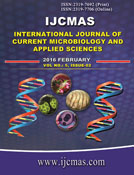


 National Academy of Agricultural Sciences (NAAS)
National Academy of Agricultural Sciences (NAAS)

|
PRINT ISSN : 2319-7692
Online ISSN : 2319-7706 Issues : 12 per year Publisher : Excellent Publishers Email : editorijcmas@gmail.com / submit@ijcmas.com Editor-in-chief: Dr.M.Prakash Index Copernicus ICV 2018: 95.39 NAAS RATING 2020: 5.38 |
The present study was conducted to detect the presence of MBLs among the isolates of Klebsiella pneumoniae by phenotypical methods and genotypic multiplex polymerase chain reaction (PCR) method among neonates with sepsis. The study included neonates who were admitted to the neonatal intensive care unit (NICU) and had suspected sepsis after hospital admission. A full laboratory sepsis screen for each neonate was performed and included cerebrospinal fluid analysis, blood cultures using BACT/Alert blood culture system and urine culture. Aerobic bacteria were identified using Microscan automated microbiological system. Bacterial isolates defined as Klebsiella pneumoniae were further subjected to microbiological laboratory studies including antibiotics susceptibility tests by disc diffusion method, determination of MBLs production by double discs and combined disc methods and determination of genotypes of MBLs-Klebsiella pneumoniae by multiplex PCR for VIM, IMP and NDM genes. MBLs-Klebsiella pneumoniae was detected among 48.1% by double discs, combined disc and genotypes respectively. The most common identified gene responsible for MBLs-Klebsiella pneumoniae was VIM (69.2%) followed by IMP and NDM (23.1% for each) and mixed genotypes were identified in 23.1%. We can conclude from this study that carbapenemase production is a common finding among the isolates of Klebsiella pneumoniae among neonates with sepsis. Both double discs and combined discs methods are accurate as screening tool for detection of resistance to carbapenem drugs. Genotypes responsible for MBLs determined VIM and IMP genes as the main prevalent genes beside NDM. Extensive studies should be carried out to determine the prevalence of MBLs- Klebsiella pneumoniae other geographic locations in Egypt to assess the magnitude of the problem. Antibiotics tigecycline and colistin are suitable for treatment under strict laboratory supervision and strict infection control practices and antibiotic policies should be strengthened to avoid the blowout of these microbial bums in our hospitals.
 |
 |
 |
 |
 |